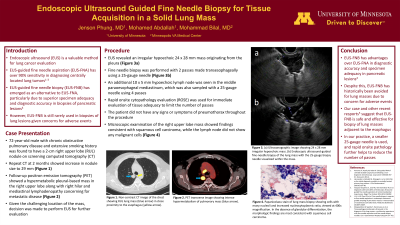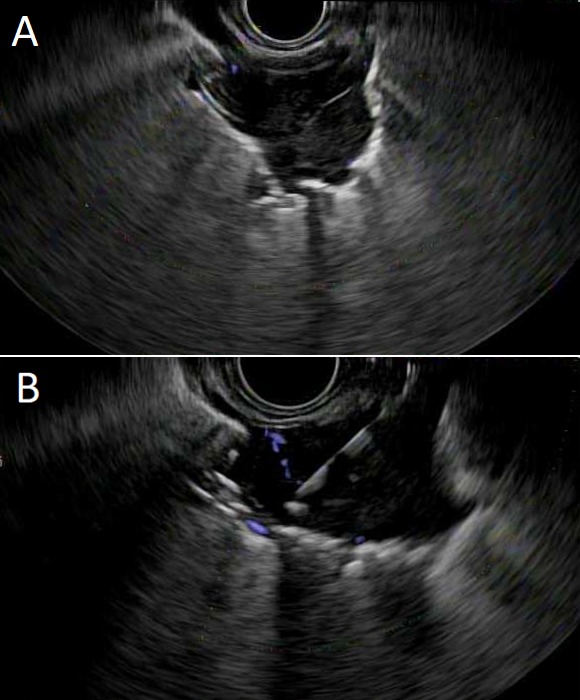Sunday Poster Session
Category: Interventional Endoscopy
P0876 - Endoscopic Ultrasound Guided Fine Needle Biopsy for Tissue Acquisition in a Solid Lung Mass
Sunday, October 22, 2023
3:30 PM - 7:00 PM PT
Location: Exhibit Hall

Has Audio

Jenson Phung, MD
University of Minnesota
Minneapolis, MN
Presenting Author(s)
Jenson Phung, MD1, Mohamed Abdallah, MD1, Mohammad Bilal, MD2
1University of Minnesota, Minneapolis, MN; 2Minneapolis VA Medical Center, Minneapolis, MN
Introduction: Endoscopic ultrasound (EUS) is a valuable method for lung cancer evaluation, with reported sensitivities of over 90% for EUS-guided fine needle aspiration (EUS-FNA) in diagnosing centrally located lung tumors. Endoscopic ultrasound-guided fine-needle biopsy (EUS-FNB) has now emerged as a superior alternative to EUS-FNA, particularly for obtaining biopsies of lesions in the pancreas, due to better specimen adequacy and diagnostic accuracy compared to EUS-FNA. However, EUS-FNB is rarely used for obtaining biopsies from lung lesions given the concerns for adverse events. Here we present a case of an EUS-FNB of a lung mass.
Case Description/Methods: A 72-year-old man with history of smoking and chronic obstructive pulmonary disease was found to have a 2 cm right upper lobe (RUL) nodule on screening computed tomography (CT). Repeat CT at 2 months showed increase in size of nodule to 29 mm. Positron emission tomography was then performed, showing a hypermetabolic spiculated pleural-based mass in the RUL as well as right hilar and mediastinal lymphadenopathy. Given the challenging location for percutaneous or endobronchial ultrasound guided biopsy, the decision was made to perform EUS after multidisciplinary discussion. EUS showed an irregular hypoechoic 24 x 28 mm mass originating from the pleura. EUS-FNB with a 25-gauge core needle was performed, and two passes were made. Additionally, a hypoechoic 10 x 5 mm lymph node in the middle paraesophageal mediastinum was also biopsied. The patient did not have any signs of pneumothorax and was discharged home. Pathological exam of the lung mass biopsy showed squamous cell carcinoma, with the lymph node only showing lymphocytes. The patient was referred for chemoradiation therapy.
Discussion: The effectiveness of EUS-guided biopsies has become increasingly recognized. EUS-FNA as a biopsy method has limitations in the amount of tissue that can be collected. EUS-FNB has advantages over EUS-FNA in both diagnostic accuracy and specimen adequacy in pancreatic mass evaluations. EUS-FNB has historically been avoided for lung masses given the risk of adverse events. Our case and other recent reports suggest that EUS-FNB is safe and effective for tissue acquisition of lung masses adjacent to the esophagus. In our practice, a smaller caliber 25-gauge needle is used, and rapid onsite pathology is used to reduce the number of passes.

Disclosures:
Jenson Phung, MD1, Mohamed Abdallah, MD1, Mohammad Bilal, MD2. P0876 - Endoscopic Ultrasound Guided Fine Needle Biopsy for Tissue Acquisition in a Solid Lung Mass, ACG 2023 Annual Scientific Meeting Abstracts. Vancouver, BC, Canada: American College of Gastroenterology.
1University of Minnesota, Minneapolis, MN; 2Minneapolis VA Medical Center, Minneapolis, MN
Introduction: Endoscopic ultrasound (EUS) is a valuable method for lung cancer evaluation, with reported sensitivities of over 90% for EUS-guided fine needle aspiration (EUS-FNA) in diagnosing centrally located lung tumors. Endoscopic ultrasound-guided fine-needle biopsy (EUS-FNB) has now emerged as a superior alternative to EUS-FNA, particularly for obtaining biopsies of lesions in the pancreas, due to better specimen adequacy and diagnostic accuracy compared to EUS-FNA. However, EUS-FNB is rarely used for obtaining biopsies from lung lesions given the concerns for adverse events. Here we present a case of an EUS-FNB of a lung mass.
Case Description/Methods: A 72-year-old man with history of smoking and chronic obstructive pulmonary disease was found to have a 2 cm right upper lobe (RUL) nodule on screening computed tomography (CT). Repeat CT at 2 months showed increase in size of nodule to 29 mm. Positron emission tomography was then performed, showing a hypermetabolic spiculated pleural-based mass in the RUL as well as right hilar and mediastinal lymphadenopathy. Given the challenging location for percutaneous or endobronchial ultrasound guided biopsy, the decision was made to perform EUS after multidisciplinary discussion. EUS showed an irregular hypoechoic 24 x 28 mm mass originating from the pleura. EUS-FNB with a 25-gauge core needle was performed, and two passes were made. Additionally, a hypoechoic 10 x 5 mm lymph node in the middle paraesophageal mediastinum was also biopsied. The patient did not have any signs of pneumothorax and was discharged home. Pathological exam of the lung mass biopsy showed squamous cell carcinoma, with the lymph node only showing lymphocytes. The patient was referred for chemoradiation therapy.
Discussion: The effectiveness of EUS-guided biopsies has become increasingly recognized. EUS-FNA as a biopsy method has limitations in the amount of tissue that can be collected. EUS-FNB has advantages over EUS-FNA in both diagnostic accuracy and specimen adequacy in pancreatic mass evaluations. EUS-FNB has historically been avoided for lung masses given the risk of adverse events. Our case and other recent reports suggest that EUS-FNB is safe and effective for tissue acquisition of lung masses adjacent to the esophagus. In our practice, a smaller caliber 25-gauge needle is used, and rapid onsite pathology is used to reduce the number of passes.

Figure: Figure 1. (A) Ultrasonographic image showing 24 x 28 mm irregular hypoechoic mass. (B) Endoscopic ultrasound-guided fine-needle biopsy of the lung mass with the 25-gauge fine needle biopsy needle visualized within the mass.
Disclosures:
Jenson Phung indicated no relevant financial relationships.
Mohamed Abdallah indicated no relevant financial relationships.
Mohammad Bilal: Boston Scientific – Consultant.
Jenson Phung, MD1, Mohamed Abdallah, MD1, Mohammad Bilal, MD2. P0876 - Endoscopic Ultrasound Guided Fine Needle Biopsy for Tissue Acquisition in a Solid Lung Mass, ACG 2023 Annual Scientific Meeting Abstracts. Vancouver, BC, Canada: American College of Gastroenterology.
